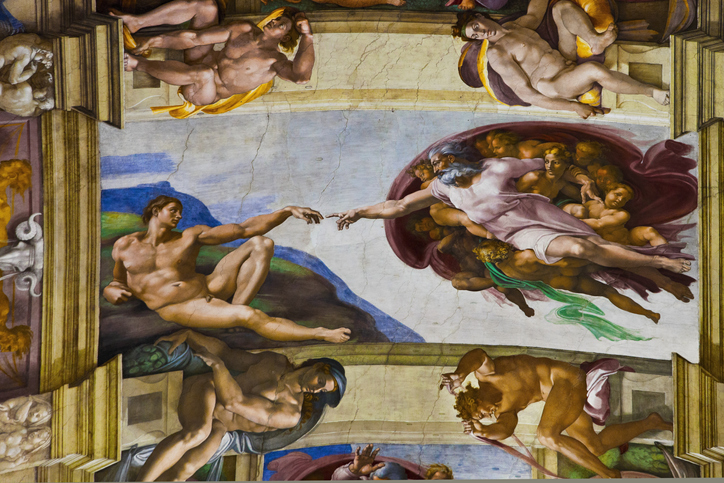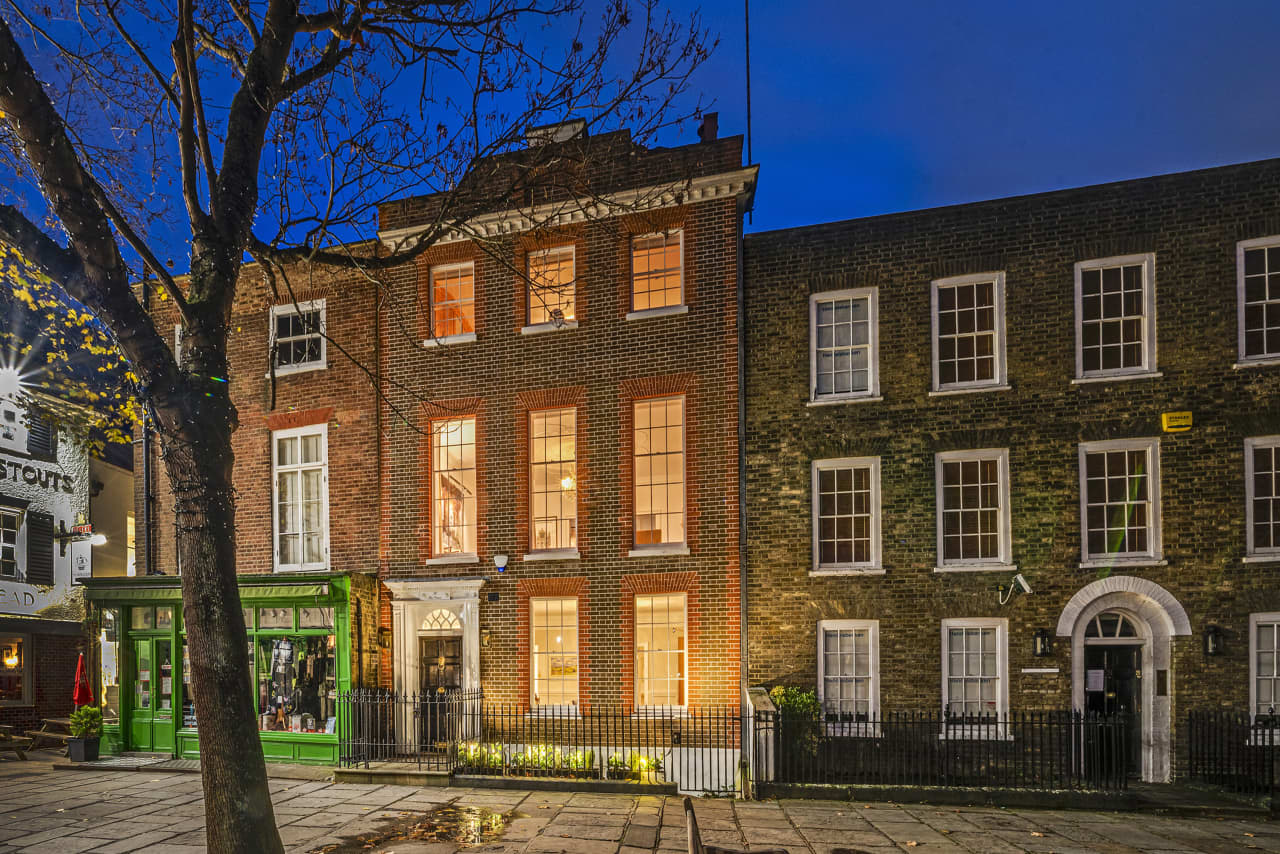Is That a Secret Michelangelo Selfie at the Sistine Chapel?
A new theory suggests that the Renaissance master modelled his iconic image of God after himself
Michelangelo may have secretly painted himself onto the ceiling of the Vatican’s Sistine Chapel, portraying himself as God with arm outstretched to spark life in a lounging Adam.
The theory, if true, underscores Michelangelo’s outsize ego, or at least his cheeky sense of humour. The hunch, which is gaining traction among Italian Renaissance scholars, also places the artist’s self-portrait squarely at the center of one of the most famous images in Western art.
“Michelangelo saw himself as the Messiah of art, so it makes sense,” said Adriano Marinazzo, a curator of special projects at Virginia’s Muscarelle Museum of Art at The College of William & Mary who published the theory last December in the peer-reviewed Italian art journal Critica d’Arte.
Although the artist painted more than 300 biblical characters across 5,000 square feet of ceiling, the central action in Michelangelo’s masterpiece is “The Creation of Adam.” The section shows an elderly, bearded God twisting beneath a floating cloak so that the fingertips on his right hand nearly reach a lackadaisical Adam, who represents mankind.
Mr. Marinazzo, who has a record of Michelangelo-related discoveries, said he made the connection after studying a sheet of paper containing a sonnet Michelangelo wrote to his friend Giovanni da Pistoia between 1509 and 1511. In the sonnet, Michelangelo complains about the physical toll the job has taken on his health.
“My brush, above me all the time, dribbles the paint so my face makes a fine floor for droppings,” the artist wrote.
In the sonnet’s margins, the artist also drew a man, presumably himself, standing with legs slightly crossed while painting a ghoulish face on the ceiling with his right arm outstretched.
Scholars have long focused on how the poem now held in Florence’s Buonarroti Archive proves Michelangelo’s ornery attitude about the papal commission. Mr. Marinazzo said he instead fixated on the sketch, wondering why the artist would portray himself standing with one leg slightly crossing the other—a shaky stance for anyone standing on scaffolding.
Mr. Marinazzo rotated a digital image of the letter last year and had an epiphany: The posture and pose of the sketched man looked eerily similar to that of God on the ceiling, a move the historian is now convinced was intentional.
“He’s hidden himself in the ceiling,” he said. “The face is idealised because Michelangelo was self-conscious about his smashed nose, but this is the closest he’s ever come to presenting himself as divine.”
Not everyone is convinced. Paul Barolsky, a Renaissance art historian at the University of Virginia, said he needs corroborating proof that the sketch inspired the final product. Michelangelo left behind hundreds of letters, including several where he wrote self-deprecatingly about his looks after a rival painter punched and broke his nose. He also created preparatory drawings of the figures’ hands in that pivotal scene on the ceiling. Never once did the artist claim to have modelled the figure of God after himself. “Everybody’s got theories, but you’ve got to do better than that,” Mr. Barolsky said.
Yet other scholars who have read Mr. Marinazzo’s hypothesis see merit in the claim.
William Wallace, a historian at Washington University in St. Louis who has written eight books on Michelangelo, said Mr. Marinazzo has made a “clever connection” about an artist whose crackling sense of humor is often overlooked. Mr. Wallace said he could “totally entertain” a theory wherein the artist painted himself as God. “He liked to laugh at himself, so this could be a hint.”
Gary Radke, an Italian Renaissance expert at New York’s Syracuse University, said he is now equally curious about the artist’s stance in the sketch. “Who stands like that on scaffolding?” Mr. Radke said. “It raises questions about interpretation, and Adriano has seen something new.”
Mr. Radke thinks the artist, who prized his own skills, may have subconsciously related to the God figure he was painting at the time.
Certainly the task before him was gargantuan. At the time Michelangelo took the commission, he was in his 30s—far younger than the God he painted—and already deemed one of Florence’s greatest sculptors, having carved “David” in Florence and the “Pietà” of St. Peter’s a few years before. He famously preferred sculpting over painting and accused his peers of recommending him for the ceiling job so they could watch him fail, scholars say.
Pope Julius II only asked him to paint the 12 apostles in the triangular shapes lining the outer edges of the barrel-vaulted ceiling, leaving the centre painted like a night sky with gilt stars. Instead, Michelangelo took over the entire span, ultimately re-creating a vast, biblical story about man’s search for God and redemption.
The result was widely hailed the moment it was unveiled in 1512, with Michelangelo’s biographer Giorgio Vasari describing the artist as “something divine rather than mortal.”
Mr. Radke said it often takes time for scholars to accept new ideas involving Michelangelo’s masterpiece. Another theory gaining traction alleges that the artist modelled the billowing cloak surrounding God after the shape of a human brain, he said. Ditto the notion that the woman and toddler tucked under God’s left arm represent Christ and his mother, Mary.
When it comes to Michelangelo selfies, there’s also precedent: Two decades after the artist finished the Sistine Chapel ceiling, Michelangelo returned to the same room to paint a wall-spanning view of Christ’s Second Coming. In 1925, a scholar first suggested that Michelangelo likely painted himself in the flayed skin held by St. Bartholomew in that work, “The Last Judgment,” and the idea has since caught on.
“Michelangelo had an ego beyond belief,” Mr. Radke said, “so all his art was autobiography to him. He was a modern artist in that way.”
 Copyright 2020, Dow Jones & Company, Inc. All Rights Reserved Worldwide. LEARN MORE
Copyright 2020, Dow Jones & Company, Inc. All Rights Reserved Worldwide. LEARN MORE
Chris Dixon, a partner who led the charge, says he has a ‘very long-term horizon’
Americans now think they need at least $1.25 million for retirement, a 20% increase from a year ago, according to a survey by Northwestern Mutual
The G80 Sport makes its entrance, displaying dynamic design details and elevated automative capabilities.
Juma Al Majid LLC, the exclusive dealer for Genesis in the UAE, has launched the G80 – a cutting-edge luxury sedan. Merging tradition with innovation, this model embodies Genesis‘ relentless pursuit of superior design, state-of-the-art technology, and unmatched luxury.
The new G80 marks a significant milestone in introducing Korean automotive excellence to the UAE, highlighting the brand’s commitment to providing exceptional experiences.
Meticulously crafted, the redesigned G80 adheres to the ‘Athletic Elegance’ design philosophy synonymous with Genesis. This luxury vehicle features refined details and cutting-edge specifications, combining comfort and style to elevate every driving experience to new heights.
“The debut of the all-new G80 in the UAE market propels our vision to converge advanced technology and refined elegance”, stated Suliman Al Zaben, Director of Genesis, UAE. “This launch is a step forward for Genesis in the UAE market and strengthens our efforts to offer ultimate luxury, innovation, and unique design to our incisive customer base.”
With a new dual-mesh design, the G80’s exterior enhances the sophisticated appearance of the Two-Line Crest Grille, paired with iconic Two-Line headlamps featuring Micro Lens Array (MLA) technology. This highlights Genesis’ commitment to harmonizing advanced technology with elegant design. The five 20-inch double-spoke wheels exude a dynamic aesthetic, resembling sleek aircraft lines, complementing the car’s parabolic side profile. Rear diffusers conceal mufflers adorned with distinctive V-shaped chrome trim inspired by the Crest Grille, embodying an eco-conscious ethos in today’s technology-driven era.

The G80 reinforces Genesis’ design philosophy in its interiors, inspired by the uniquely Korean concept of the Beauty of White Space, integrated with state-of-the-art technology to create cosmetic brilliance for users. The 27-inch-wide OLED display seamlessly combines the cluster and AVN (Audio, Video, Navigation) screen in a horizontal layout, extending to the center fascia, showcasing its flair for innovative technology. The touch-based HVAC (Heating, Ventilation, and Air Conditioning) system offers ease of control, while the redesigned crystal-like Shift By Wire (SBW) ensures a comfortable grip, infusing a sense of luxurious convenience.
With its dual-layered Crest Grille and expanded air intakes, the G80 Sport package delivers a dynamic and sporty spirit. Exclusive interior options, such as a D-cut steering wheel and carbon accents, enhance its sporty allure. Equipped with Rear Wheel Steering (RWS) and Electronic Limited Slip Differential (E-LSD), the G80 Sport 3.5 twin turbo model is built for stable control during high-speed maneuvers.
Fitted with advanced safety and convenience features, this luxury sedan includes Remote Smart Parking Assist 2, Lane Following Assist 2, and a Fingerprint Authentication System. The three-zone HVAC system provides customized climate control for all passengers. With two powertrain options – a 2.5 turbo engine delivering 300 horsepower and 43.0 kgf·m of torque, and a 3.5 twin turbo engine producing 375 horsepower and 54.0 kgf·m of torque – superior driving dynamics ensure a silent and luxurious driving experience.

Chris Dixon, a partner who led the charge, says he has a ‘very long-term horizon’
Americans now think they need at least $1.25 million for retirement, a 20% increase from a year ago, according to a survey by Northwestern Mutual





















